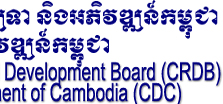|
Section D:
Harmonization and Streamlining |
|
Results |
Actions Needed |
Responsible
RGC Institutions |
Lead
Donor |
Milestones |
Timing |
|
1.
Donor-Donor harmonization is strengthened to reduce transaction costs and
to maximize ODA benefits for Cambodia |
|
a) Decrease burden on the
Government in the formulation of Donors' strategies and plans.
|
(i) Donors prepare joint country assistance strategies.
ii) Donors deliver their assistance through SWAps, SWiMs and PBAs.
|
CDC, MEF and concerned Ministries
Sector ministries
|
TWGs
TWGs
|
Fewer stand alone donor country strategies.
At least two more SWAPs prepared.
SWAPs in other areas formulated.
|
on-going
June 2005
December 2006
|
|
b) Donor field offices have sufficient authority to enable the
implementation of country-based harmonization initiatives.
|
(i) Donors HQ's take action to decentralize authority to their Cambodia
country offices to provide maximum flexibility in implementing the
harmonization action plan.
(ii) Donor country Offices take actions to tackle HQ constraints where
these occur.
|
CDC
CDC
|
Donor HQs, and country offices
Donor country offices
|
HQ's delegate the authority to country offices needed to implement
Cambodia's Action Plan on Harmonization and Alignment.
Information on donor country office constraints to harmonize shared at
GDCC meetings.
|
January-December 2005.
on-going
|
|
c) Donors further harmonize their practices at the implementation stages
of sector programs.
|
(I) Existing and new TWGs work on sector harmonization action plan
appropriate to their circumstances, including addressing salary
supplementation issues. |
CDC, CAR, and MEF
|
TWG/PAR/PFM
|
Harmonization Action Plan for the sector prepared and agreed between RGC
and donors, including salary supplementation issue.
|
December 2005
|
|
(i)
Donors integrate PIUs/PMUs into
RGC's institutional structures. |
Concerned ministries
|
TWGs
|
PIUs/PMUs integrated into Government structures by 2007
|
2005
|
|
d) Donors commit to eliminating duplication of activities.
|
(i)
All new activities to be peer
reviewed by TWGs to avoid duplication/gaps, and maximize synergies.
|
CDC and concerned ministries
|
TWGs
|
TWG report on steps taken to reduce duplication.
|
2005
|
|
f) Donors
undertake fewer missions, and increase the proportion of joint missions
especially for analytical work, sector review, evaluation and monitoring.
|
(i) TWGs prepare
a calendar of planned donor missions in their area. |
CDC and line
ministries |
TWGs
|
Reduced number
of donor missions. |
2005 |
|
g) Donors
decrease the burden on government of project management |
(i) TWGs use
SMART indicators to reduce the burden of project management.
|
CDC and line
ministries |
TWGs
|
Indicators
prepared. |
2005 |
|
(ii) Increased
number of delegated cooperation/lead agency arrangements.
|
CDC and line
ministries |
TWGs
|
Non resident
donors deliver their assistance through delegated cooperation arrangements |
2005 |
|
(iii) Increased
donor commitment to multi-year resourcing, linked to government multi-year
budgeting system.
|
MEF |
TWGs
|
|
2005 |
|
(iv) Increased
number of joint donor missions. |
CDC |
TWGS |
Increase
proportion of joint missions by 10% pa, decrease individual missions by 10
p.a. |
2005 |







